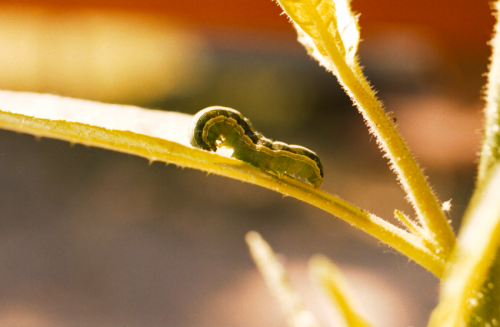December 24, 2014 report
Study suggests virus impacts caterpillar's phototactic response causing them to climb

(Phys.org) —A small team of researchers with Wageningen University in The Netherlands has found evidence that suggests that a type of virus that causes a species of caterpillar to climb higher up a plant, does so by causing a change to the victim's phototactic response. In their paper published in the journal Biology Letters, the team describes how they studied baculovirus infections in caterpillars and the experiments they conducted in attempting to show that changes in behavior attributed to the viral infection were likely due to changes in how light was perceived.
As the researches note, many types of parasites try to manipulate their hosts into behaving in ways that benefit the parasite, e.g. malaria parasites causing changes in mosquito feeding behavior and the way hair worms cause crickets to engage in suicidal behavior. In this new study, the researchers wanted to better understand how the parasite Spodoptera exiqua, a baculovirus, is able to cause the Beet Armyworm (Spodoptera exigua) larvae to climb up leaves and plants prior to dying.
Prior research has shown that after being infected with the virus, S. exigua caterpillars climb in ways that are out of the norm for them. They climb up the trees they are living on, often to the very top (giving rise to the informal name of the ailment—treetop disease) before they die from the infection—which allows the virus to be spread very easily to other caterpillars below. Up until now, no one really knew what mechanism was in put in place by the virus to cause the behavior change in the caterpillar. In this new effort, the researchers believe they have discovered that the virus actually causes the caterpillar to perceive light differently.
By observing both healthy and infected caterpillars in their lab, and by altering light conditions, the researchers found that healthy caterpillars never climb to the top of the plants they are on. They also found that once mature, the caterpillars actually move lower before turning into immobile pupae. In contrast, caterpillars exposed to the virus began climbing within three days of infection and then continued climbing for up to 14 hours. When the lights were turned off though, the researchers found that infected caterpillars did not climb as much and wound up at lower elevations before they died.
The researchers have concluded that the infection likely involves the virus capturing host pathways that are involved in phototaxis in the caterpillars or other processes involved in light perception.
More information: Baculovirus infection triggers a positive phototactic response in caterpillars to induce 'tree-top' disease, Biology Letters, Published 24 December 2014. DOI: 10.1098/rsbl.2014.0680
ABSTRACT
Many parasites manipulate host behaviour to enhance parasite transmission and survival. A fascinating example is baculoviruses, which often induce death in caterpillar hosts at elevated positions ('tree-top' disease). To date, little is known about the underlying processes leading to this adaptive host manipulation. Here, we show that the baculovirus Spodoptera exigua multiple nucleopolyhedrovirus (SeMNPV) triggers a positive phototactic response in S. exigua larvae prior to death and causes the caterpillars to die at elevated positions. This light-dependent climbing behaviour is specific for infected larvae, as movement of uninfected caterpillars during larval development was light-independent. We hypothesize that upon infection, SeMNPV captures a host pathway involved in phototaxis and/or light perception to induce this remarkable behavioural change.
Journal information: Biology Letters
© 2014 Phys.org




















